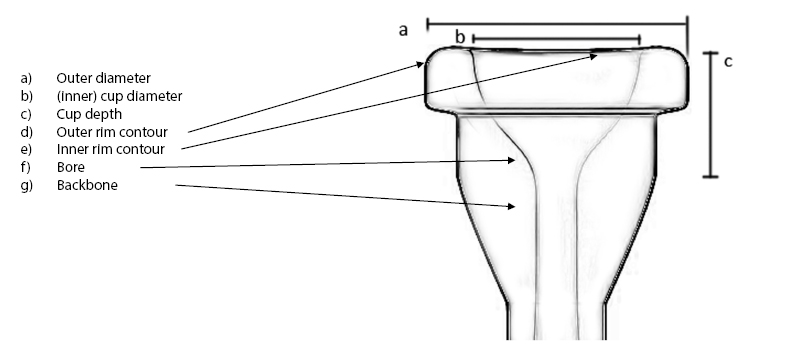The Mouthpiece - the Link between the Player and the Instrument
Introduction
Dear fellow trombonist,
Even those who have been playing the trombone for years may be unaware of it: brass instruments are the only instruments where the player is the only tonegenerator. Our lips produce vibrations that need to be transferred onto the instrument in the best possible way. Anything we do needs to pass through the mouthpiece, which is therefore of prime importance.
1) Beginners
Trombones have shafts of different sizes. Your dealer will be able to inform you about your trombone’s shaft size. Otherwise, surf to www.jupiter.info to find out more about the shaft size of your JUPITER trombone. More often than not, a student trombone comes with a mouthpiece to allow you to start playing right after unpacking it. That mouthpiece is usually labeled “6 1/2” or “7C”. The “6 1/2 AL” refers to a large shaft (L is short for “large”). The above indications are standard sizes that work for most players. JUPITER trombones also come with a mouthpiece. In most instances, it is wiser to stick to it until you feel the need for a different mouthpiece, e.g. when your teacher recommends switching to another type.
Tip: beginners should never experiment with mouthpieces! Their lips need some time to get used to their new task. Trying out a variety of mouthpieces is more likely to harm than to help you.
2) Advanced and Pro Players
Those purchasing a trombone for advanced players should be aware of the fact that such instrument come with a 7C mouthpiece or similar. The reason for this is simple: most advanced players have probably already found the mouthpiece that suits them best. Still, every wind instrument is expected to come with a mouthpiece. This explains why professional instruments, like the XO trombones, are supplied with a standard mouthpiece.
3) Size Matters
Nobody quite knows how many manufacturers specialize in mouthpieces. The most famous German ones are no doubt Bruno Tilz and Josef Klier. Yet, mouthpieces are manufactured in every part of the world. Where do you find an overview of the available sizes and shapes?
The best way to tackle this is to have a close look at a mouthpiece:

“All theory, dear friend, is gray,” is what the German poet Goethe wrote in “Faust”. Never mind all the comparison charts on the internet: they are just figures and letters that won’t help you find the mouthpiece that feels just right.
Tip: the wider and deeper the cup and the larger the bore, the easier it will be for the sound to develop inside the instrument. Yet, this also means you need to practice more in the high register. Although a shallow cup makes it easier to play high notes, it also invariable affects the sound quality.
I have been playing the trombone for almost 40 years. I also worked at a music store with a big wind and brass department for 11 years where I advised countless customers. The most important aspect for the feel is the initial contact with the mouthpiece. We are all different—and that is why there are so many shapes and sizes. The inner and outer rim contour greatly contribute to the “right fit” of a mouthpiece. Never mind the softness or accentuation of the rim. The cup depth and width are something one needs to get accustomed to—or ultimately reject. It often takes time to establish whether the selected mouthpiece is indeed perfect for you. And even if it is, it may take 3~4 months for your muscles to grow accustomed to the mouthpiece.
Tip: always solicit the advice of your trusted dealer before buying a new mouthpiece! He or she will select a shortlist and then send you home with a number of mouthpieces for you to test at leisure.
But don’t just test the mouthpieces during your daily practice—be sure to also use them during band and orchestra rehearsals, for that is when you will really experience their feel and response.
4) Special Mouthpieces
4a) Quite a few players are allergic to nickels. Even though most mouthpieces are silver-plated, they are never made of solid silver and likely contain nickel. If this applies to you, be sure to select a mouthpiece with a gold-plated rim and cup, or a completely gold-plated mouthpiece. Obviously, you can also have your favorite mouthpiece gold-plated.
4b) Some musicians who frequently play outdoors prefer a plastic mouthpiece, because it tends to feel warm. Yet, there are only a few mouthpieces of this type on the market. If you like, a professional mouthpiece manufacturer can produce a perfect copy of your favorite mouthpiece. But don’t expect it to behave exactly like the original in all registers. Its mass and its weight indeed also play an important part. This is illustrated by the
4c) “Heavy-weights”. Mouthpieces with an extremely high mass, so-called “heavy” models, have been around for years. The idea behind them is to transform the vibrations you generate with your lips almost loss-free into sound. The mouthpiece’s high mass ensures that no vibration energy is lost. Whether this is indeed a better approach remains to be seen, though.
4d) “Oddities” I have found a manufacturer who specializes in mouthpieces with an idiosyncratic shape. All instruments of the trumpet family (to which the trombone belongs) have a U-shaped mouthpiece with a matching cup. Instruments of the horn family, on the other hand, use V-shaped mouthpieces. I once tried out a trombone mouthpiece with a V-shaped cup. Even though its incredibly mellow sound appealed to me, I realized that it was not what I needed or preferred.
Testing is above studying
To summarize the above: try out as many models as you possibly can. Do not rush things when it comes to making a decision. I would like to close with a personal remark. Some players like to discuss the mouthpiece played by the famous XY for hours on end. Never buy a mouthpiece in the hope that you will sound like your hero(ine). Chances are that anybody who plays the instrument really well has practiced real hard.
Enjoy playing the trombone!
Mike Rafalczyk


